Intel’s latest “Arrow Lake” desktop processor, otherwise known as the Core Ultra 200S, delivers a shocking one-two punch: significantly lower power consumption and package temperatures compared to its predecessor, while delivering comparable performance.
Well, that’s not entirely true. Intel admits that the “geomean” of several gaming benchmarks for the new Ultra Core 7 265K is actually 5 percent lower than the older Core i9-14900K, and it might fall short against AMD as well. But Intel believes that the power meter will be the benchmark of choice when evaluating Arrow Lake, with power consumption that can draw well over 100 watts less than its predecessor.
Arrow Lake’s power claims are a huge deal and Intel’s not backing down. “Arrow Lake picks up the mantle of Raptor Lake’s top-end gaming performance and delivers parity performance at about half the power,” said Roger Chandler, vice president and general manager for enthusiast PC and workstation product marketing at Intel, in a briefing with reporters.
Sales and preorders of Intel’s five new Arrow Lake desktop chips begin October 24 for about the same prices as 14th-gen Core chips. These new chips will fit into a new LGA 1851 socket, which will necessitate new motherboards using Intel’s new 800 chipset. Existing chip coolers will work, but you may need new mounting hardware to ensure the proper pressure is applied, Intel executives said.
All of this makes Arrow Lake one of the more interesting chips to talk about in some time. And there’s a lot to talk about.
Intel typically unveils a new chip’s architecture first, then releases the names of the actual products and their estimated performance later. With this release, Intel has elected to provide all of its Arrow Lake information in one fell swoop, minus one part: details of the mobile components. Intel is holding back details on the Arrow Lake-HX and Arrow Lake-H parts for gaming laptops and performance notebooks until early Q1 2025, very likely at the CES show in Las Vegas.
Right now, we’re talking about Arrow Lake-S. Many enthusiasts will care only about what Arrow Lake-S desktop chips are going to ship, how fast they’ll run, what they’ll cost, and how well they’re expected to perform. I’m going to cover all of that, but I also highly recommend that you refer to our deeper dive into Arrow Lake’s architecture. (That one includes more details about what you can expect in Arrow Lake laptops.)
For more Intel news, be sure to check out the following articles:
Which processors are part of the Arrow Lake family?
Intel’s Core Ultra 200S series, or Arrow Lake, is Intel’s first “disaggregated” processor for the desktop, consisting of tiles — compute, GPU, SOC, and I/O tiles along with a “filler” and “base” tile for stability — all linked together using Intel’s Foveros technology inside a single package. Save for the base tile, all are manufactured at TSMC: the compute (TSMC’s N3B), the GPU (TSMC’s N5P), and the I/O and SOC tiles (TSMC’s N6) are all connected to Intel’s 1227.1 base tile.
Arrow Lake uses the same Lion Cove performance cores (P-cores) and Skymont efficiency cores (E-cores) as Lunar Lake, but the anemic NPU of Meteor Lake. Remember, low power was the big push behind Lunar Lake, and you can understand why Intel’s continuing the trend into desktops. For one thing, the summer months in the US are becoming increasingly brutal and power prices continue to soar. For another, Qualcomm and other Arm providers are always threatening.

Intel has five Core Ultra 200S chips for you to buy, ranging from the Intel Core Ultra 5 245KF at a maximum speed of 5.2GHz up to the Core Ultra 9 285K at 5.7GHz. Two of the new Core Ultra 200S chips carry an “F” suffix, meaning they lack an integrated GPU that will have to be replaced by a discrete graphics card.
- Intel Core Ultra 9 285K: 24 cores (8 P-cores, 16 E-cores, 5.7GHz max); 4 GPU cores, 13 TOPS NPU, $589
- Intel Core Ultra 9 265K: 20 cores (8 P-cores, 12 E-cores, 5.5GHz max); 4 GPU cores, 13 TOPS NPU, $394
- Intel Core Ultra 9 265KF: 20 cores (8 P-cores, 12 E-cores, 5.5GHz max); 0 GPU cores, 13 TOPS NPU, $379
- Intel Core Ultra 9 245K: 14 cores (6 P-cores, 8 E-cores, 5.2GHz max); 4 GPU cores, 13 TOPS NPU, $309
- Intel Core Ultra 9 245KF: 14 cores (6 P-cores, 8 E-cores, 5.2GHz max); 0 GPU cores, 13 TOPS NPU, $294
Intel’s 14th-gen desktop Core lineup launched with the same range from $294 to $589, leaving these processors relatively inflation-proof.
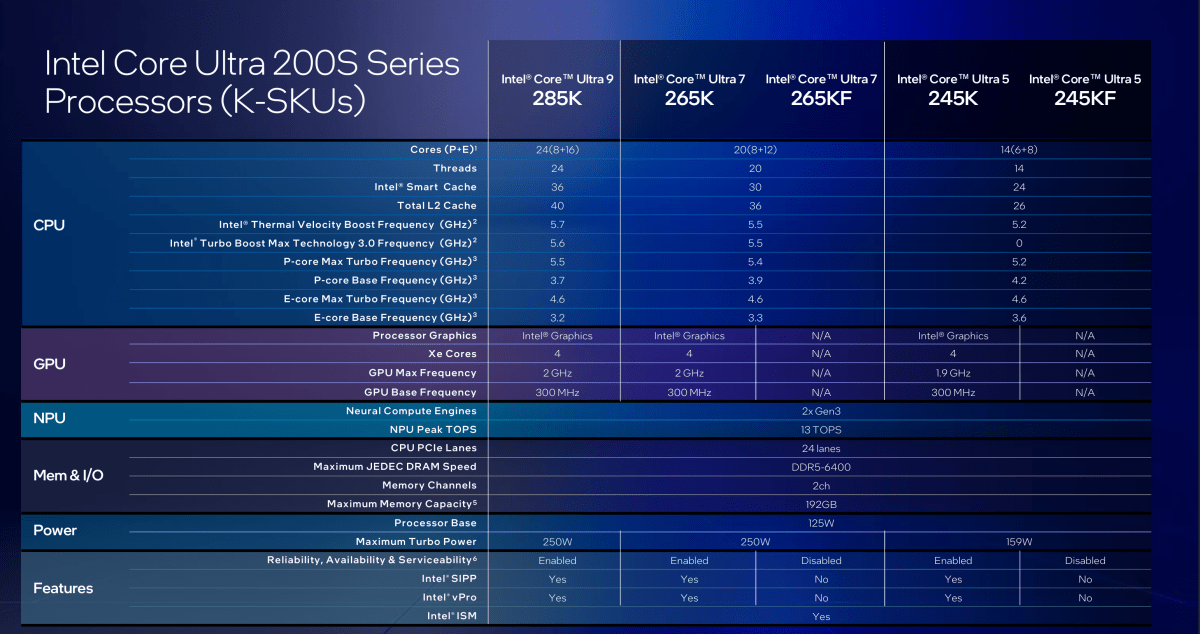
Will there be more members of the Core Ultra 200S family in the future? Almost certainly. Robert Hallock, an Intel vice president who oversees Intel’s consumer AI, said that there are “possibilities in the future, including more F-series parts that lack an integrated GPU.”
And yes, Intel has skipped the “Core Ultra 100S” brand on the desktop.
Arrow Lake cuts power dramatically, at some cost to performance
Most enthusiasts understand that power and performance are related. Increase the power on a chip and performance usually scales up with it. An improvement in process technology usually offers the option to increase performance at the same power, or reduce power at the same performance. Improvements to Intel’s P-cores and E-cores provide additional knobs for Intel’s designers to turn.
But it’s not the same this time around: Intel believes that it has reduced the power and increased the performance, too. (Again, if you want more details on how it did this, see our Arrow Lake deep dive.)
Intel slices this relationship up a number of different ways, but this is the important chart:

Intel
Procyon Office Productivity is a benchmark that tries to replicate the office work you do in your day, bouncing back and forth between Excel, Outlook, PowerPoint, and Word. You obviously make Zoom calls, too. The other two benchmarks (AI and Cinebench) are less important, but the message in this slide is pretty clear: if you work on a desktop, the power that desktop consumes should drop by… almost half?
And in gaming, we have the other side of the coin: performance is “on par” with the older Core i9-14900K but with big drops in power, between 34 watts to 136 watts by Intel’s own estimates — possibly as high as 150 watts, depending upon the title. Intel also estimates that the package temperature is about 13 degrees Celsius cooler on average than Raptor Lake Refresh.
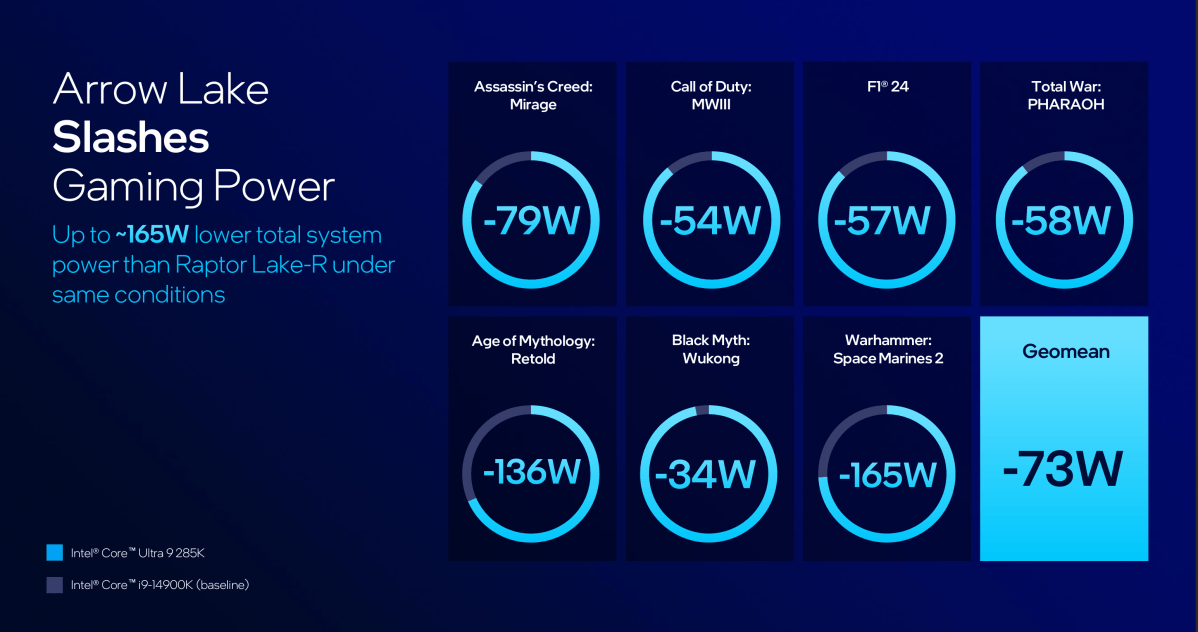
Intel
Intel hopes that you’ll be swayed by its low-power arguments, perhaps after months of talk about the efficiency of Arm’s own power-sipping architecture. “Gamers game a few hours a day,” Intel’s Hallock said, “so we have to think about the total power consumption footprint of the product over its life cycle.”
There’s another potent argument in favor of Arrow Lake, summed up on the slide below. Some users deliberately “undervolt” their processors, trying to run them with as little power as possible without impacting performance. Intel tested six popular games, from Assassin’s Creed Mirage to Red Dead Redemption 2 to Total War Pharoah and found that the games ran “on par” (+/- 3 percent of performance) when run at 250W, 175W, and at 125W. In other words, configuring the PC to deliver half the power didn’t measurably affect performance, Intel says.
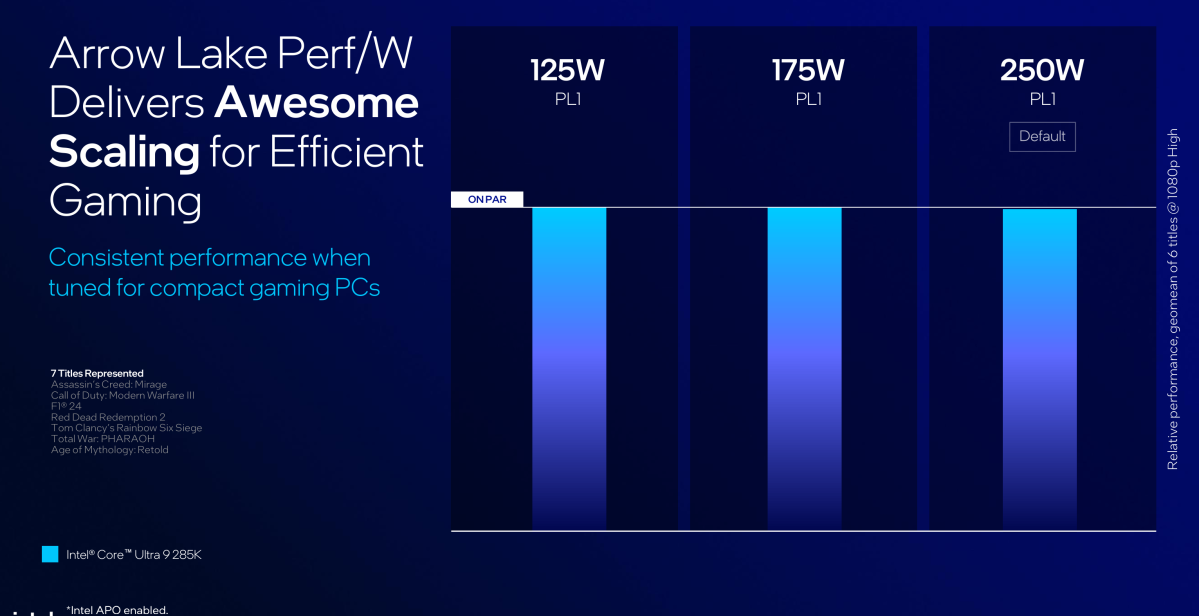
Intel
But in terms of actual gaming performance, it’s not a clear-cut win for Intel. On a mix of games, Intel tracked several wins, ties, and even losses compared to the older 14th-gen chip.
Note that a lot of these games use Intel’s Application Optimization (IAO) technology, which is a way of routing tasks to the more powerful P-cores. A recent Advanced Mode lets you force the features on older games. Intel has made this IAO technology a feature of the 14th-gen Core and now this second Core Ultra 200S family, but not on older processors.
Interestingly, Intel’s Hallock said that the power profile on the 14th-gen Raptor Lake Refresh tests was set to “extreme” while Arrow Lake’s power profile was set a step down to “performance.” The TJMax (i.e., the temperature at which the processor implements safety mechanisms to avoid overheating) is 105 degrees Celsius, which is about normal.

Intel
Typically, Intel’s chief competition comes from the AMD Ryzen 9950X or other members of its family. AMD’s X3D family also goes head-to-head, although the massive amounts of cache AMD devotes to those processors can put AMD in a class of its own.
What Intel didn’t show off was how the X3D processors compare in terms of power. When we tested AMD’s 7950X3D in 2023, the chip was relatively efficient: “During our Cinebench R23 multi-core test, the 7950X3D’s total system power draw dropped average wattage use by about 31 percent compared to the 13900K, and 36 percent versus the greedier 13900KS.”
When put up against the 7950X, Intel’s in-house testing shows that Arrow Lake doesn’t do great in gaming but much better in content creation.

Intel
Intel compared Arrow Lake to the AMD Ryzen 9950X and found the performance is pretty close. Again, though, there are several games when the 9950X outperforms Arrow Lake. (If AMD has something waiting in the wings, this could be the time to strike. After all, Ryzen is a hot rod.)
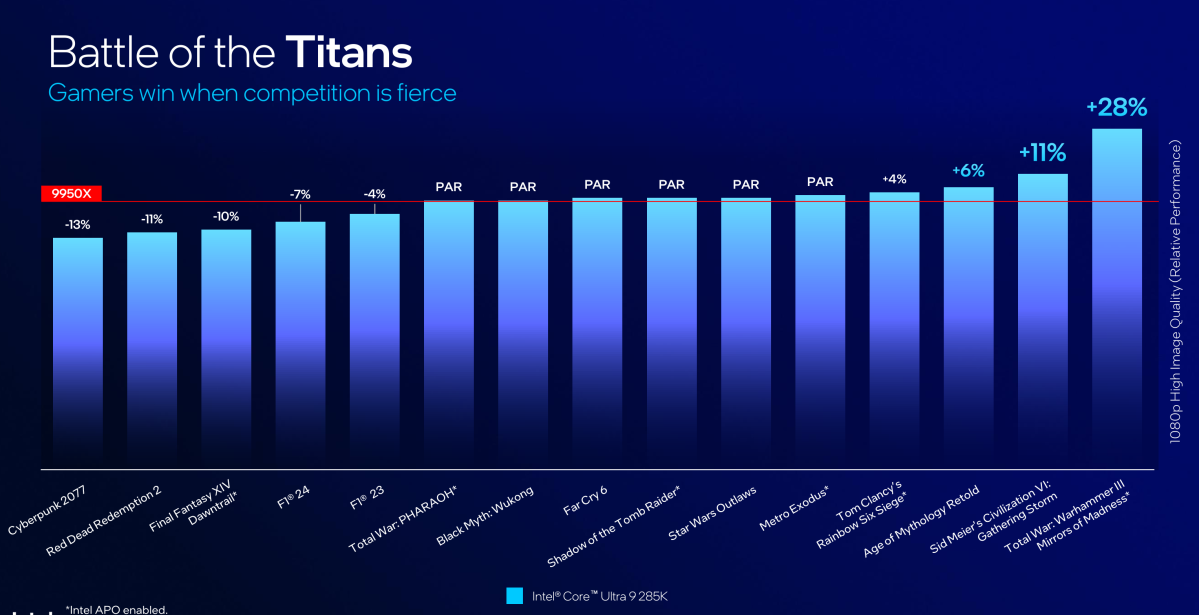
Intel
Intel’s Hallock was frank when asked about how the Core Ultra 200S will fare against AMD’s parts: “I think what we said is that we showed some data on the 7950X3D based on my understanding of the performance. That part is within a couple percent. So I think we’ll be about 5 percent back versus X3D parts, which we feel really, really good about, considering we have just the cache that’s built into the CPU and the great IPC of the product. But yeah, you’ll see about a 5 percent deficit. And I want to be clear about that.”
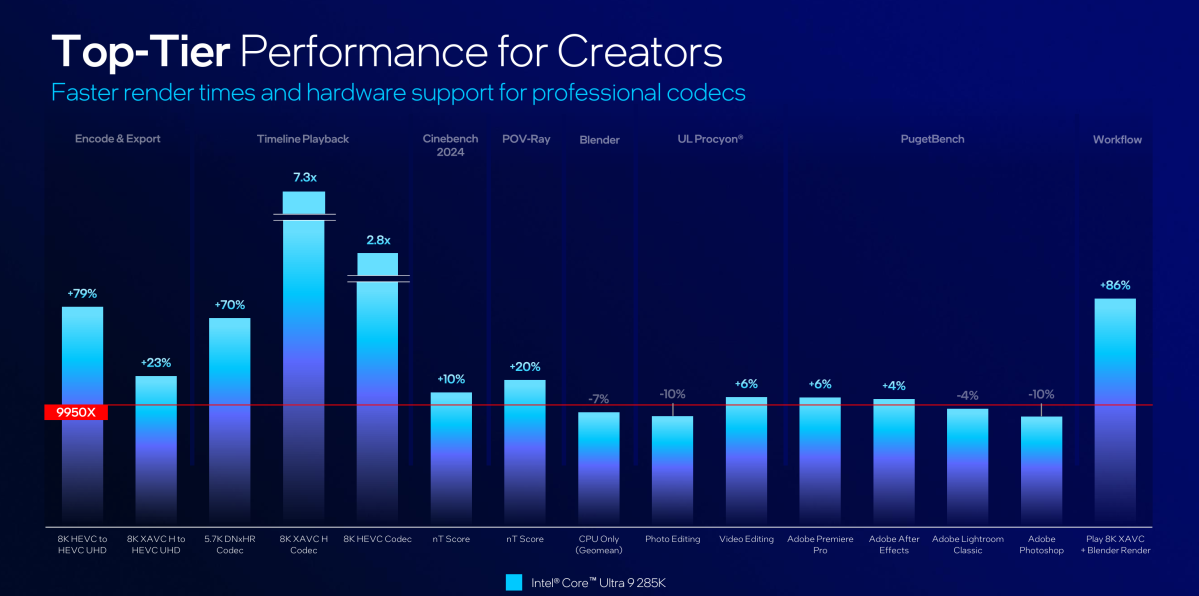
Intel
It feels like Intel may be positioning itself for more of a push into corporate systems, where the combination of “less power” and “good performance in content creation” could provide a compelling argument for corporate customers. Intel has yet to launch a vPro version, however, and a next-gen AMD X3D part could overcome Intel with brute force.
Why does Arrow Lake use an older NPU? And other questions
Unfortunately, Intel isn’t disclosing how long it plans to support its new LGA socket. Some other pieces of the puzzle are coming to light, too.
Our deeper dive into Arrow Lake talks about Intel’s new Intel 800 chipset, which will feature up to 192GB (48GB per DIMM) of up to DDR5-6400 memory, which will require module makers to step up. If you want to use XMP technology, Intel imagines DDR5-8000 will be the “sweet spot.”
Look for 48 PCIe lanes (of which 20 are PCIe 5.0) to play with as well as Thunderbolt 4 to make an appearance (but not Thunderbolt 5). Intel executives said they’re playing it conservative on integrating functions, letting PC makers add in discrete components like Wi-Fi 7 to add value and differentiate themselves.
And as for the NPU, Arrow Lake integrates the 13-TOPS NPU 3 found in Meteor Lake. With enthusiasts somewhat skeptical about what AI can do for them, Intel decided to play it safe.
What this all does, though, is give everyone in the enthusiast community a lot more to talk about. Will gamers care more for pure gaming performance than lower power? Or will consumers remember their perpetually warming summers and try to keep the extra heat out of their houses? Will any power savings Intel provides simply be gobbled up by the extra 150 watts expected to be consumed by Nvidia’s upcoming GeForce 5090 Blackwell GPUs? How will AMD respond?
The conversation will kick off on or around October 24 when Arrow Lake starts moving out the door.



